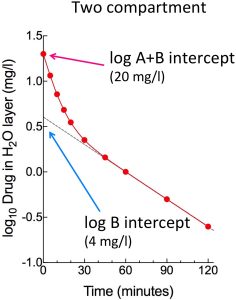A+B Intercept
 The intercept with the Y-axis of the plot of plasma concentration versus time data for a drug that follows two compartment kinetic behaviour. This (extrapolated) intercept with the Y-axis (concentration axis) is equal to the theoretical concentration of drug in the plasma at time = 0 if drug had mixed evenly throughout the central compartment but there had not yet been any distribution into tissues lying outside the central compartment, or any elimination from the body. In other words, the entire dose of the drug would still be present in the central compartment. Accordingly, the volume of the central compartment can be calculated from the dose (mg) divided by the A+B intercept value (mg/litre). For example, if a dose of 250 mg was administered IV and the A+B intercept was 9.4 mg/litre, the volume of the central compartment would be 26.6 litres.
The intercept with the Y-axis of the plot of plasma concentration versus time data for a drug that follows two compartment kinetic behaviour. This (extrapolated) intercept with the Y-axis (concentration axis) is equal to the theoretical concentration of drug in the plasma at time = 0 if drug had mixed evenly throughout the central compartment but there had not yet been any distribution into tissues lying outside the central compartment, or any elimination from the body. In other words, the entire dose of the drug would still be present in the central compartment. Accordingly, the volume of the central compartment can be calculated from the dose (mg) divided by the A+B intercept value (mg/litre). For example, if a dose of 250 mg was administered IV and the A+B intercept was 9.4 mg/litre, the volume of the central compartment would be 26.6 litres.
Typically, the volume of the central compartment includes the volume of the plasma itself, plus cellular water associated with tissues (e.g. blood vessel walls) that are in close contact with the blood and into which drug can partition almost instantly. For a drug that distributes very rapidly into at least some tissues, the contribution to the total volume of distribution from those tissues may be reflected in the calculated volume of the central compartment, which would be the sum of the plasma volume, the volume of cellular water in close proximity to blood vessels, and the volume of any tissues into which the drug distributes very rapidly. Tissues into which lipophilic drugs typically distribute rapidly include highly-vascularised tissues such as liver, kidney and brain.

